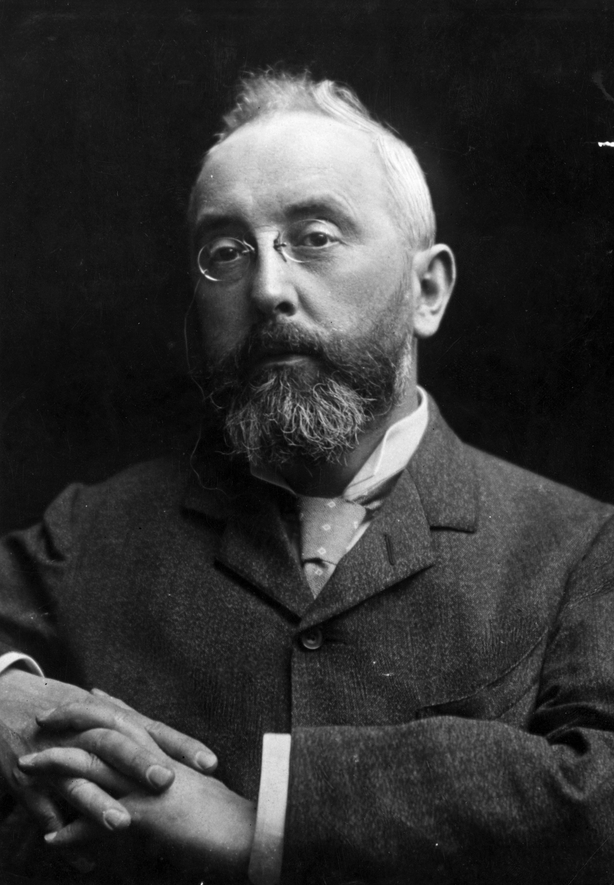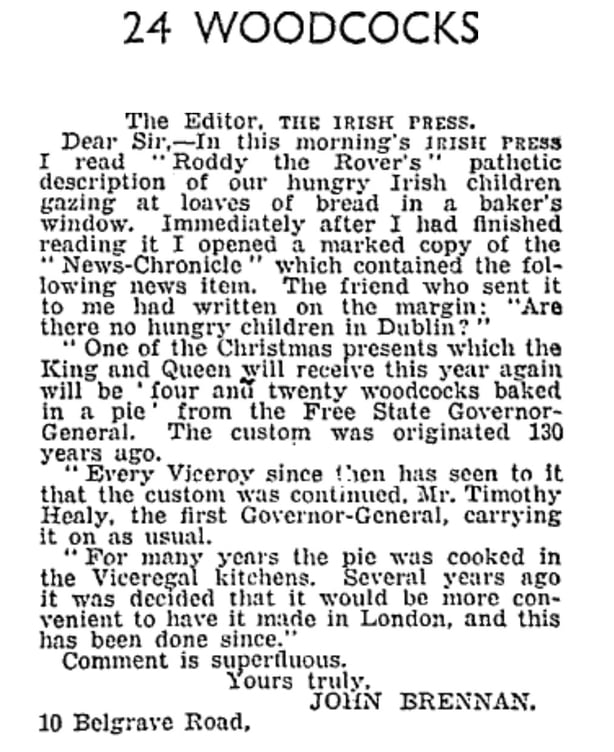Analysis: Ireland used to send a woodcock pie to the British monarch every Christmas, but a letter and Domhnall Ó Buachalla put a stop to it
By Sonja Tiernan, RIA
A surprising Irish Christmas tradition, established in the early nineteenth century, caused much controversy after the establishment of the Irish Free State. Charles Chetwynd-Talbot served as viceroy of Ireland from 1817 to 1821. As the British monarch’s representative in Ireland, Lord Talbot sent a woodcock pie to King George III, who was particularly partial to game.
Although now rarely eaten, woodcock was considered the highest quality of Irish game at the time. Taking his inspiration from the old children’s rhyme ‘Sing a Song of Sixpence’ by Mother Goose, Talbot arranged for 24 woodcocks to be baked in a pie and sent to the king, to be eaten as part of the royal Christmas dinner:
Sing a song of sixpence,
A pocket full of rye,
Four and twenty blackbirds
Baked in a pie.
When the pie was opened
The birds began to sing—
Wasn’t that a dainty dish
To set before the king?
Talbot established what became an annual tradition. For many years the pie was cooked in the kitchens of the viceregal lodge in the Phoenix Park, now Áras an Uachtaráin. It was sent by special courier to the monarch’s residence, with a Christmas greeting. The Irish dish was served cold on Christmas Day and featured prominently on Queen Victoria’s Christmas menu throughout her reign. In later years the Irish viceroy arranged for 24 woodcocks to be sent to London, where the pie was cooked locally.
In January 1922 the last viceroy, Edmund Bernard FitzAlan-Howard, officially handed over power to Michael Collins and the provisional Irish government. After the Free State was established in December 1922, the position of viceroy was formally abolished and replaced by that of governor-general of the Irish Free State. The requirement for a representative of the British monarch in Ireland was abhorrent to nationalists; this was a vivid reminder of the dominion status of the Irish Free State.
An agreement was reached between the British and Irish Free State governments to appoint T.M. Healy to the position, as he was viewed as an elderly statesman who could fulfil the ceremonial duties of governor-general. Healy was sworn in on 6 December 1922 and he served in the post until January 1928. A governor-general of Northern Ireland was also created, who could no doubt have continued the tradition of sending a Christmas pie to the reigning monarch.

Healy, however, continued the tradition. Woodcocks were duly sent every year to London, where the pie was baked and presented to the monarch at Christmastime on behalf of the governor-general of the Irish Free State. After his term ended in 1928, Healy was replaced by James McNeill, an experienced diplomat. McNeill’s term in office was relatively uneventful and he continued with the annual Christmas tradition, which did not seem to gain much public attention in Ireland.
On 12 December 1931, however, John Brennan of 10 Belgrave Road, Rathmines, wrote a letter to the Irish Press newspaper signalling his disdain for this Christmas tradition. Brennan described how he had read reports that morning of starving children in Dublin. After reading the report, he had opened a copy of the News-Chronicle, a British newspaper, which reported that the king and queen would receive a present of four and twenty woodcocks baked in a pie from the Irish Free State governor-general. While it is not certain who John Brennan was, the address that he gave was that of prominent republicans Una and Robert Brennan. Belgrave Road had earned the moniker of ‘Rebel Road’ owing to the abundance of notable political activists among its occupants, including Hanna Sheehy Skeffington, Kathleen Lynn and Madeleine ffrench Mullen.
Brennan noted in his letter how governors-general in the Free State had simply continued the Christmas tradition. This would change, however, when Eamon de Valera came into power just weeks later. In February 1932 Fianna Fáil, under the leadership of de Valera, formed a government with the support of the Labour Party.

De Valera set to work on dismantling symbols of British rule in Ireland, starting with the position of governor-general. Throughout 1932 de Valera ensured that McNeill was not granted any privileges by the government, and he was not invited to attend official functions. Most significantly, McNeill was excluded from State preparations for the Eucharistic Congress to be held in Dublin in June that year. This resulted in what historian Michael Kennedy has called a growing cold war between the governor-general and the Irish executive.
Matters came to a head in October 1932, when de Valera submitted a request to King George V for McNeill to be relieved of his post, which came into effect almost immediately. De Valera put forward a strong republican figure, Domhnall Ó Buachalla (Donal Buckley), as his replacement. Ó Buachalla, an Irish-speaker, refused to be addressed by the title of governor-general, insisting on using An Seanascal (chief steward) instead.
From British Pathé, New governor General of Ireland, Domhnall Ó Buachalla poses for photographs after taking the oath in 1932
The use of an Irish-language title was just the beginning of a systematic plan to devalue the office of governor-general in Ireland. Ó Buachalla did not reside in the official residence of the viceregal lodge, choosing instead to live in a modest house in the suburbs of Dublin. He rejected all ceremonial roles associated with the British monarch’s representative in Ireland and was rarely even seen in public, let alone at official events.
Not surprisingly, Ó Buachalla abruptly ended the tradition of sending a Christmas pie to the king. The Tralee newspaper The Liberator reported the end of the tradition with glee, noting that this move was particularly welcomed by the people of Dublin, who had popularised a new verse in the ‘Sing a Song of Sixpence’ rhyme:
When the pie was opened
The birds began to sing:
Three Cheers for Donal Buckley
No pastry for the King.
The position of governor-general of the Irish Free State was abolished in 1936. As historian Marie Coleman notes, by that time the office had virtually ceased to exist.
This is an edited extract of the author's piece as published in Christmas & The Irish: A Miscellany (Wordwell) edited by Salvador Ryan
Follow RTÉ Brainstorm on WhatsApp and Instagram for more stories and updates
Professor Sonja Tiernan is a historian of modern Ireland and coordinator of the Irish Humanities Alliance /Comhaontas Daonnachtaí na hÉireann, based at the Royal Irish Academy.
The views expressed here are those of the author and do not represent or reflect the views of RTÉ

